A guide to AD digestate applicators
Growers taking AD digestate to offset mineral fertiliser usage get a good shot of nitrogen, some phosphate, potash and with the right kit can also get free cultivation as part of the bargain.
Contractors and plant operators are now using an array of tillage tools – some bespoke, some based on established cultivators – to place and cover the liquid on stubbles or previously cultivated ground.
Tine-based
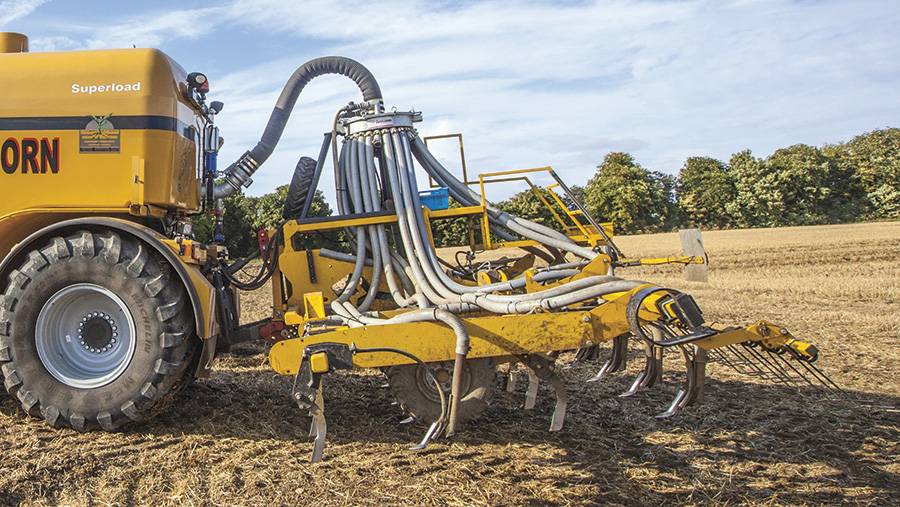
© Dave Franciosy
Claydon
The Claydon Injector is based on the chassis and tines of the familiar Hybrid drill and strip injects digestate directly into stubble at 300mm or 600mm row spacing.
Carbide-tipped leading tines penetrate the soil to a depth of about 150mm to create a void and the following flexible tines place the slurry.
See also: Rights, wrongs, rules and regulations for tractors on the road
Rear harrows then sweep soil over the strips to ensure that ammonium nitrate is not lost to the air and any odour impact is kept to a minimum.
With the added ability to place or broadcast oilseed rape behind the injector, the implement is reckoned to also offer a versatile and cost-effective way of establishing high yielding crops.
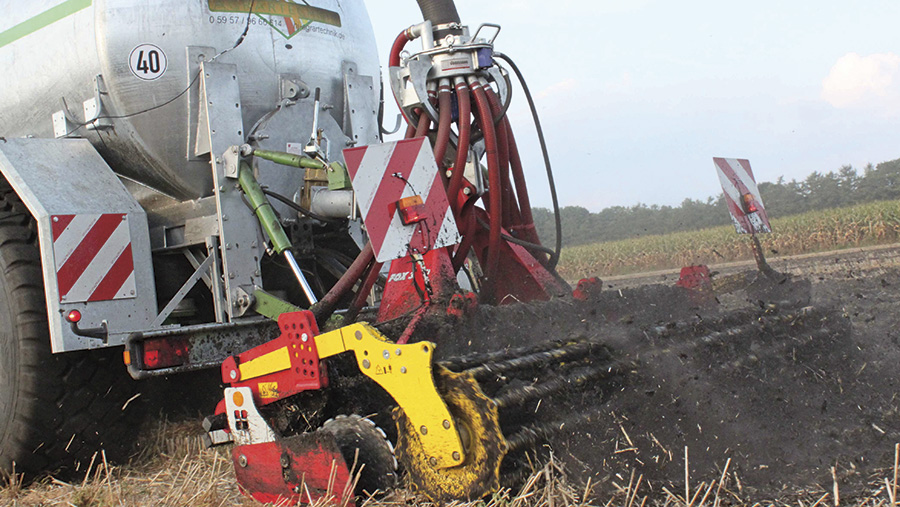
Vogelsang SynCult
Vogelsang
With its XTill implement, German manufacturer Vogelsang builds a tool that can also dispense rapeseed or pave the way for separate sowing of maize, sugar beet or oilseed rape into prepared strips of tilth.
The XTill ProTerra, which has row spacing fixed at 75cm, and the XTill VarioCrop, which has adjustable row spacing between 45cm and 75cm, dispense digestate at root level from a rigid tine.
An added feature of the VarioCrop model, which is now adjustable without spanners or other tools, is digestate placement at two adjustable depths simultaneously.
Kverneland
A macerator and distribution head kit for injecting liquid turns Kverneland’s Kultistrip into a digestate applicator, with variable spacing of the cultivated strips – adjustable from 45-80cm apart – suiting crops from sugar beet and oilseed rape to maize.
The cultivating units, which have parallel linkage to maintain correct alignment, are clamped to a square tube toolbar and all adjustments are made tool-free.
There are 3m rigid and 4.5m and 6m folding models, with a choice of tine point designs to suit different working depths, soil types and working speeds.
A crumbler roller, soft rubber press wheel and “V” bar crumbler are available to get the finish required in different soil conditions.
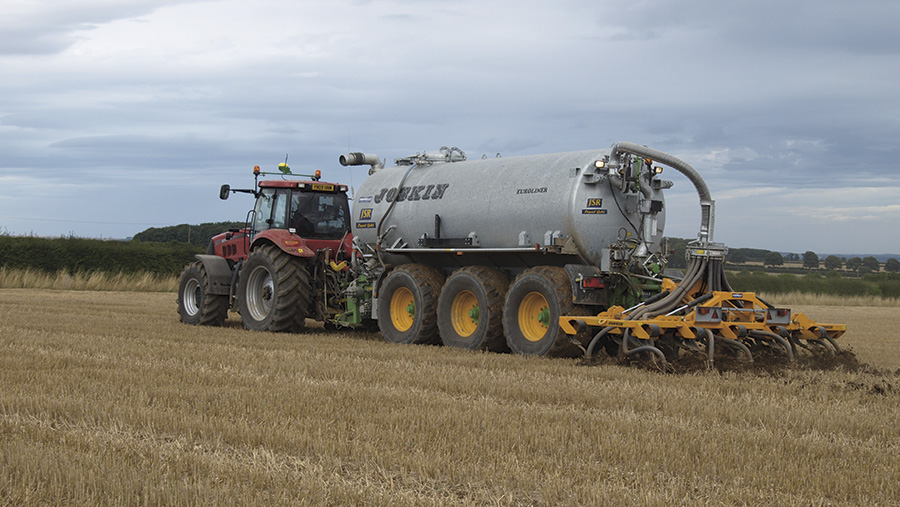
Joskin Euroliner Terraflex
Joskin
The Terrasoc rigid tine and Terraflex flexible tine arable injectors from Joskin have injection spacings of 30cm or 40cm across widths to 7.6m. The Terraflex/3 has a three-row layout for maximum clearance.
Joskin’s own Scalper macerator is fitted to the distributor head in each case, which uses small freely rotating circular blades to deal with any fibrous material.
Evers Agro
Dutch manufacturer Evers Agro produces 10 different tined cultivator-injection units reflecting the widespread use of direct-to-soil application techniques used in the Netherlands.
There are different configurations of rigid and medium- or heavy-duty spring tines arranged in two or three rows, build specs to suit farm or contractor operations, and overall working widths of 4.5m to 10.2m.
The Vogelsang Dosimat distribution head is a common feature.
Disc-based
Samson
Disc cultivating units have the versatility to work on stubbles or ploughed ground and Samson Agro’s “SD” incorporator has the company’s vertical distributor and is available in 5m, 6m and 7m widths, folding to 2.95m for transport.
It deploys two rows of 510mm diameter concave discs positioned 25cm apart, with digestate applied into the furrow created by each leading disc and then covered by a second working in the opposing direction.
A 630mm open crumbler consolidates tilth as well as regulating working depth, although a hydraulic depth control system is available to help keep weight on the tractor for traction.
Samson Agro says the SD can incorporate 10-70t/ha and work at up to 18kph, as well as performing effectively at slower speeds.
A similar galvanised two-row disc unit from Joskin also comes with 510mm diameter scalloped discs working up to 18cm deep.
Vogelsang
Vogelsang produces its SynCult liquor application kits for several established short disc cultivators for mounting on tankers, including the Amazone Catros, Horsch Joker, Pöttinger Fox 300D and Väderstad Carrier CRX 425, 525 and 625 models.
The conversion package requires no drilling or welding and comprises an adapter frame, a precision liquid distributor, conveying and discharge pipes and all brackets.
While these implements all have discs operating at a fixed angle, the Evers Toric disc harrow injector has stepless adjustment so the effect of the 560mm discs can be fine-tuned to suit conditions.
It comes in four sizes from 4.65m to 6.45m with 30cm disc spacing, with APV pneumatic broadcasting units available for simultaneous digestate application and seeding.
Case study: A&R Cramphorn, Oakham, Leicestershire

Rob Cramphorn © Dave Franciosy
Digestate application now accounts for about three-quarters of Rob Cramphorn’s tanking workload, handled in the main by a pair of self-propelled TerraGators with a choice of arable injectors in place of wide trailing shoe and dribble bar units.
“We started out using a spring tine cultivator injector, but found we couldn’t always get good penetration on dry, heavy soils, or we might bust a tine on a tramline.
“Claydon built an injector based on the Hybrid drill frame and tines and that works a treat injecting into stubbles on heavy clay soils,” he says.
Two such units are now available to the team, a 6m and 6.6m version with two additional tines for the more powerful of the two TerraGators, both of which operate with crab steering to spread the load.
“The Claydon injectors will rip into anything, even a tramline based hard, and come out the other side, so it’s good on stubbles,” says Mr Cramphorn.
“But it’s not the best on land that’s been ploughed.”
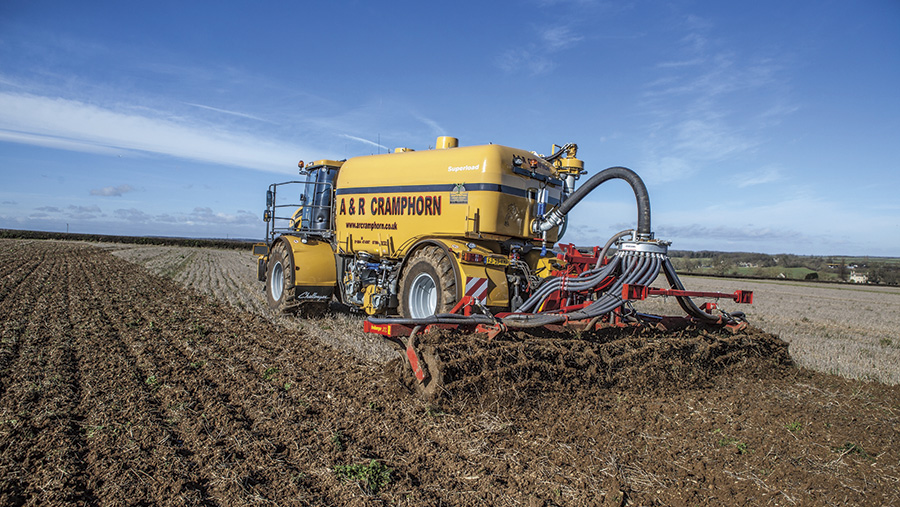
© Dave Franciosy
Which explains why there are also the original and two new Evers spring tine cultivator injectors, which in addition to ploughed land, are also suited to stubble work on lighter soils and work wider at 7.3m apiece.
“All the injectors have ‘A’ frames so we can transport them on the back of a tractor and swap them over in about five minutes,” notes Rob Cramphorn.
“Having a crumbler roller on the back gives accurate depth control, keeps the implement dead level and leaves a decent finish.”
Case study: Aylsham Slurry Services, Norfolk

Chris Key
A home-made cultivator-injector has made way for a converted Väderstad Carrier CRX 425 on the new Abbey tanker operated behind a 240hp tractor by Chris Key from his Norfolk base.
“The home-made unit worked well enough, but had a job taking the wheelings out of ploughed land being prepared for maize,” he explains.
“The Carrier does a better job – and I was attracted by the sealed bearings for the discs because digestate is very aggressive.”
Weighing just over 3t, the 4.25m Carrier is mounted on a specially devised heavy-duty three-point linkage, with has some free movement built in to allow the cultivator and tanker to move separately over ground undulations.
“Another good feature is the way the divided tank empties from the back first,” notes Mr Key.
“It’s not until the tank is about two-thirds empty that the front compartment opens, so there’s always plenty of weight on the tractor to maintain grip.”
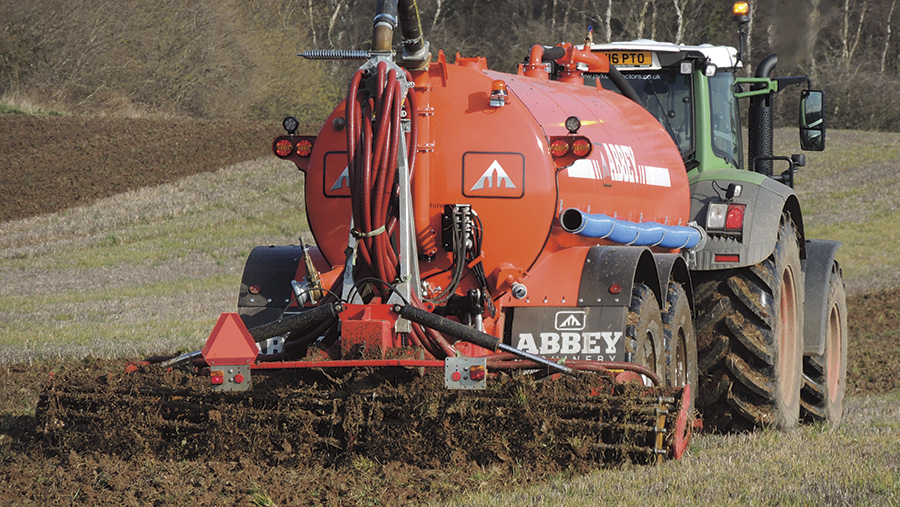
Abbey tanker with Vaderstad Carrier
Growers receiving digestate can choose between having it dribbled on the surface using a 15m applicator or cultivated in.
The latter is proving popular on post-harvest stubbles where it creates a stale seed-bed and on overwintered ploughing in preparation for maize.
“Going for the discs takes a cultivation pass out of the tillage programme and is useful for levelling ground, especially after a wet spring, in readiness for final seed-bed preparation for sowing,” says Mr Key.
Different approaches to establishing cover crops are being tried – broadcasting off the front of the tractor and working in with the discs as the digestate goes down or drilling them a couple of days after application when the seed-bed has dried a little.
The jury’s out on which is the better approach, says Mr Key, but could inform thoughts on sowing rapeseed as the digestate goes on.

